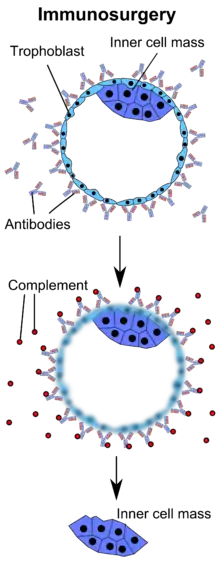Immunosurgery
Immunosurgery is a method of selectively removing the external cell layer (trophoblast) of a blastocyst through a cytotoxicity procedure. The protocol for immunosurgery includes preincubation with an antiserum, rinsing it with hES derivation media to remove the antibodies, exposing it to complement, and then removing the lysed trophoectoderm through a pipette.[1] This technique is used to isolate the inner cell mass of the blastocyst. The trophoectoderm's cell junctions and tight epithelium "shield" the ICM from antibody binding by effectively making the cell impermeable to macromolecules.[2][3]

Immunosurgery can be used to obtain large quantities of pure inner cell masses in a relatively short period of time. The ICM obtained can then be used for stem cell research and is better to use than adult or fetal stem cells because the ICM has not been affected by external factors, such as manually bisecting the cell.[4][5] However, if the structural integrity of the blastocyst is compromised prior to the experiment, the ICM is susceptible to the immunological reaction. Thus, the quality of the embryo used is imperative to the experiment's success. In addition, when using complement derived from animals, the source of the animals matters. They should be kept in a specific-pathogen-free environment to increase the likelihood that the animal has not developed natural antibodies against the bacterial carbohydrates present in the serum (which can be obtained from a different animal).[6]
Solter and Knowles developed the first method of immunosurgery with their 1975 paper "Immunosurgery of Mouse Blastocyst". They primarily used it for studying early embryonic development.[4][7] Though immunosurgery is the most prevalent method of ICM isolation, various experiments have improved the process, such as through the use of lasers (performed by Tanaka, et al.) and micromanipulators (performed by Ding, et al.).[8][9] These new methods reduce the risk of contamination with animal materials within the embryonic stem cells derived from the ICM, which can cause complications later on if the embryonic stem cells are transplanted into a human for cell therapy.
References
- Häggström, Mikael (2014). "Allogeneic component to overcome rejection in interspecific pregnancy". WikiJournal of Medicine. 1 (1). doi:10.15347/wjm/2014.004.
- Cruz, Y. P.; Treichel, R. S.; Harsay, E.; Chi, K. D. (1993-01-01). "Mouse Blastocyst Immunosurgery with Commercial Antiserum to Mouse Erythrocytes". In Vitro Cellular & Developmental Biology. Animal. 29A (8): 671–675. JSTOR 4294104.
- Nichols, Jennifer; Boroviak, Thorsten (2015). "Maximizing Clonal Embryonic Stem Cell Derivation by ERK Pathway Inhibition". Embryonic Stem Cell Protocols. Methods in Molecular Biology. 1341. pp. 1–13. doi:10.1007/7651_2015_253. ISBN 978-1-4939-2953-5. PMID 26026883.
- Solter, D; Knowles, BB (1975). "Immunosurgery of mouse blastocyst". Proceedings of the National Academy of Sciences of the United States of America. 72 (12): 5099–102. Bibcode:1975PNAS...72.5099S. doi:10.1073/pnas.72.12.5099. PMC 388883. PMID 1108013.
- Crook, Jeremy M.; Kravets, Lucy; Peura, Teija; Firpo, Meri T. (2017). "Derivation of Human Embryonic Stem Cells". Stem Cell Banking. Methods in Molecular Biology. 1590. pp. 115–129. doi:10.1007/978-1-4939-6921-0_8. ISBN 978-1-4939-6919-7. PMID 28353265.
- “Production of Chimeras,” Chapter 11, in Manipulating the Mouse Embryo, 3rd edition, by Andras Nagy, Marina Gertsenstein, Kristina Vintersten, and Richard Behringer. Cold Spring Harbor Laboratory Press, Cold Spring Harbor, NY, USA, 2003.
- Amit, Michal (2013). "Sources and Derivation of Human Embryonic Stem Cells". Pluripotent Stem Cells. Methods in Molecular Biology. 997. pp. 3–11. doi:10.1007/978-1-62703-348-0_1. ISBN 978-1-62703-347-3. PMID 23546743.
- Tanaka, Noriko; Takeuchi, Takumi; Neri, Queenie V.; Sills, Eric Scott; Palermo, Gianpiero D. (2006-01-01). "Laser-assisted blastocyst dissection and subsequent cultivation of embryonic stem cells in a serum/cell free culture system: applications and preliminary results in a murine model". Journal of Translational Medicine. 4: 20. doi:10.1186/1479-5876-4-20. ISSN 1479-5876. PMC 1479373. PMID 16681851.
- Yan Ding, Yi Gan, Jing Bo Feng, Shao Hua Qi, Rui Ming Li, Dong Sheng Li. "Efficient isolation inner cell mass from blastocysts by improved microsurgical technique". Cell Research (2008) 18:s39. doi: 10.1038/cr.2008.129; published online 4 August 2008